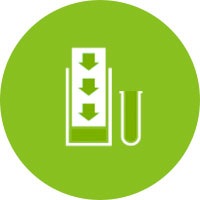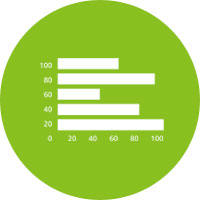National Agronomy Manager, Scott Baker, looks at Spring Cropping in his latest agronomic update.
With current market conditions, applying sub-optimal fertiliser rates, is a likely scenario for many arable and grassland farmers this Spring. However, there's still a lot farmers can do to get their crop to harvest and maintain a good quality and yield.

 You can read more about getting the crop off to the right start, in a previous Crop Nutrition update, here.
You can read more about getting the crop off to the right start, in a previous Crop Nutrition update, here.
 SAP sampling procedures are crop specific. Full details and sampling instruction are supplied in your dedicated ‘SAP Pack’. You can sample when problems are seen, when the crop is under stress, or prior to a growth surge.
You should take your sample in a representative manner, either in a pre-marked “W” or in a straight line and select the oldest actively growing leaf from at least 20 plants.
Contact our Crop Nutrition Agronomist, Scott Baker, for more information and to get your SAP Pack.
SAP sampling procedures are crop specific. Full details and sampling instruction are supplied in your dedicated ‘SAP Pack’. You can sample when problems are seen, when the crop is under stress, or prior to a growth surge.
You should take your sample in a representative manner, either in a pre-marked “W” or in a straight line and select the oldest actively growing leaf from at least 20 plants.
Contact our Crop Nutrition Agronomist, Scott Baker, for more information and to get your SAP Pack.
 Once we’ve received your sample our expert lab and research team prepare the samples for testing using the facilities of the Scientific Agricultural Partnership (SAP®) laboratories in King’s Lynn.
The laboratories specialise in the extraction, analysis and interpretation of sap samples taken from growing plants.
Once we’ve received your sample our expert lab and research team prepare the samples for testing using the facilities of the Scientific Agricultural Partnership (SAP®) laboratories in King’s Lynn.
The laboratories specialise in the extraction, analysis and interpretation of sap samples taken from growing plants.
 The sample is then analysed to show 17 different nutrient levels including: No3, NH4, P, K, Mg, S, Ca, Na, Cl, Mn, B, Cu, Fe, Zn, Mo, Al, and pH
The sample is then analysed to show 17 different nutrient levels including: No3, NH4, P, K, Mg, S, Ca, Na, Cl, Mn, B, Cu, Fe, Zn, Mo, Al, and pH
 The results from the sample are then assessed by our team of FACTS qualified agronomists who provide the farmer with an easy to interpret bar chart, alongside agronomist comments. These recommendations are emailed within 2-3 days of receipt of the samples.
The results from the sample are then assessed by our team of FACTS qualified agronomists who provide the farmer with an easy to interpret bar chart, alongside agronomist comments. These recommendations are emailed within 2-3 days of receipt of the samples.
 With rapid turnaround sample results, alongside dedicated Crop Nutrition Agronomists comments, you can apply exactly what your crop needs this Spring.
With rapid turnaround sample results, alongside dedicated Crop Nutrition Agronomists comments, you can apply exactly what your crop needs this Spring.
 Bio 20 is is an effective stressbuster. Expect a rapid visual improvement following application to crops under stress. When used as part of a nutrient management programme, Bio 20 helps to create larger or bolder harvestable produce, resulting in higher crop yield. You can find out more about how Bio 20 boosts crops, here.
Bio 20 is is an effective stressbuster. Expect a rapid visual improvement following application to crops under stress. When used as part of a nutrient management programme, Bio 20 helps to create larger or bolder harvestable produce, resulting in higher crop yield. You can find out more about how Bio 20 boosts crops, here.

Application
Getting application right this Spring is crucial, not only financially, but to ensure your crop is able to get off to the best start. Choosing an N+S grade will be a wise choice. Sulphur is a key component when growing high yielding, healthy crops. Whilst Nitrogen is a growth promoter, sulphur works as a growth regulator, effectively balancing the manufacture of sugars and proteins in leaf tissue with the demand from these materials throughout the plant. Consequently, sulphur plays a crucial role in maintaining green leaf area, growth rates and delaying senescence. Low sulphur levels reduce Nitrogen metabolism, leaf expansion and plant development. The nutrient is very mobile in the soil meaning wet winters and early springs leave low reserves in the soil. Crops need a steady supply throughout rapid growing seasons, so it’s key to apply S each time N is applied. Consult your local FACTS qualified advisor for the most efficient rate of sulphur to be applying with your chosen N rate. You should also be considering the use of a nitrification inhibitor, such as DIDIN. Nitrogen Use Efficiency, has arguably never been so important, so ensuring your nitrogen stays in the ground and isn't lost into the atmosphere will pay dividends. DIDIN not only reduces emissions, it helps improve yield. Trials have shown using DIDIN is responsible for:- 7.7% yield increase
- 66% reduction in nitrous oxide emissions
- 49.5% reduction in nitrate leaching

Roots, roots, roots
As my colleague, Richard Cameron, highlighted in his podcast it's all about the "roots, roots, roots." Plant stress is likely to be high this year, due to lower N rates throughout the field, so building a strong root structure and getting the crop off to the best possible start is one of the most important things to be considering. By giving your crop a Kickstart with a dose of foliar nutrition, the plant will be provided with a boost to improve crop establishment and root growth. The rooting stimulator in Kickstart is based on phosphite, a key nutrient shown to promote early root growth in young plants, and formulated with nitrogen and potassium. You can read more about getting the crop off to the right start, in a previous Crop Nutrition update, here.
You can read more about getting the crop off to the right start, in a previous Crop Nutrition update, here.
Monitor your crops
It probably goes without saying, that the importance of monitoring crops throughout spring with SAP testing is likely to be much greater than normal years, where crops are much closer to the tipping point, checking crops through the spring with a SAP test will prove to be a wise, low-cost investment, giving you the flexibility to react with foliar nitrogen top-ups if needed. The below 5 step guide highlights how to conduct a SAP test.Step 1: Take the sample
 SAP sampling procedures are crop specific. Full details and sampling instruction are supplied in your dedicated ‘SAP Pack’. You can sample when problems are seen, when the crop is under stress, or prior to a growth surge.
You should take your sample in a representative manner, either in a pre-marked “W” or in a straight line and select the oldest actively growing leaf from at least 20 plants.
Contact our Crop Nutrition Agronomist, Scott Baker, for more information and to get your SAP Pack.
SAP sampling procedures are crop specific. Full details and sampling instruction are supplied in your dedicated ‘SAP Pack’. You can sample when problems are seen, when the crop is under stress, or prior to a growth surge.
You should take your sample in a representative manner, either in a pre-marked “W” or in a straight line and select the oldest actively growing leaf from at least 20 plants.
Contact our Crop Nutrition Agronomist, Scott Baker, for more information and to get your SAP Pack.
Step 2: Preparation
 Once we’ve received your sample our expert lab and research team prepare the samples for testing using the facilities of the Scientific Agricultural Partnership (SAP®) laboratories in King’s Lynn.
The laboratories specialise in the extraction, analysis and interpretation of sap samples taken from growing plants.
Once we’ve received your sample our expert lab and research team prepare the samples for testing using the facilities of the Scientific Agricultural Partnership (SAP®) laboratories in King’s Lynn.
The laboratories specialise in the extraction, analysis and interpretation of sap samples taken from growing plants.
Step 3: Analysis
 The sample is then analysed to show 17 different nutrient levels including: No3, NH4, P, K, Mg, S, Ca, Na, Cl, Mn, B, Cu, Fe, Zn, Mo, Al, and pH
The sample is then analysed to show 17 different nutrient levels including: No3, NH4, P, K, Mg, S, Ca, Na, Cl, Mn, B, Cu, Fe, Zn, Mo, Al, and pH
Step 4: Results
 The results from the sample are then assessed by our team of FACTS qualified agronomists who provide the farmer with an easy to interpret bar chart, alongside agronomist comments. These recommendations are emailed within 2-3 days of receipt of the samples.
The results from the sample are then assessed by our team of FACTS qualified agronomists who provide the farmer with an easy to interpret bar chart, alongside agronomist comments. These recommendations are emailed within 2-3 days of receipt of the samples.
Step 5: Application
 With rapid turnaround sample results, alongside dedicated Crop Nutrition Agronomists comments, you can apply exactly what your crop needs this Spring.
With rapid turnaround sample results, alongside dedicated Crop Nutrition Agronomists comments, you can apply exactly what your crop needs this Spring.
Biostimulants
A recent article in CPM by myself, and Technical Development Manager David Booty, highlighted the importance of only using Biostimulants when they're needed, as they perform much better when the crop is suffering stress. Latest trials demonstrate this perfectly, as pictured below. Bio 20 is is an effective stressbuster. Expect a rapid visual improvement following application to crops under stress. When used as part of a nutrient management programme, Bio 20 helps to create larger or bolder harvestable produce, resulting in higher crop yield. You can find out more about how Bio 20 boosts crops, here.
Bio 20 is is an effective stressbuster. Expect a rapid visual improvement following application to crops under stress. When used as part of a nutrient management programme, Bio 20 helps to create larger or bolder harvestable produce, resulting in higher crop yield. You can find out more about how Bio 20 boosts crops, here.
Speak to a FACTS qualified advisor
It's important you check in with your local FACTS qualified advisor. OMEX's team of dedicated liquid fertiliser experts are highly trained, alongside assistance from myself and our global technical teams, we're here to help you get the best out of your crops this Spring. You can use our handy postcode locator tool to find out who your local contact is, here.
